 |
|
Beauty is in the details. Click
on the photos to see them in a larger size. Use your browser's
"Back" button to return. |
|
|
|
|
Introduction |
|
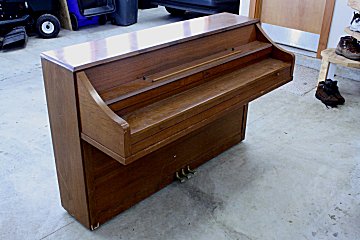 So
you inherited Grandma's old hand-me-down furniture or maybe you
found that ideal piece at the flea market, but it is showing a lot
of signs of wear and tear from years of abuse then sitting in a
storage shed for 20 years. Restoring an old piece of furniture
is not as easy as some of the do-it-yourself television shows may
lead you to believe. Sure, if you want to slap a coat of paint
on it and deem it "shabby sheik" then go for it. However,
bringing back the beauty of the original stained wood and fixing the
broken bits correctly and inconspicuously requires time, patience,
and experience. Many folks might be up for the task on the
first day, then quickly lose interest once they understand the
commitment required. So
you inherited Grandma's old hand-me-down furniture or maybe you
found that ideal piece at the flea market, but it is showing a lot
of signs of wear and tear from years of abuse then sitting in a
storage shed for 20 years. Restoring an old piece of furniture
is not as easy as some of the do-it-yourself television shows may
lead you to believe. Sure, if you want to slap a coat of paint
on it and deem it "shabby sheik" then go for it. However,
bringing back the beauty of the original stained wood and fixing the
broken bits correctly and inconspicuously requires time, patience,
and experience. Many folks might be up for the task on the
first day, then quickly lose interest once they understand the
commitment required.
Let me throw this out there right up front: You will NOT save money
by having a piece of furniture restored. You will certainly be
able to buy a similar piece of quality furniture for less.
Restoration is very time consuming, and time is money. Save
restoration for those items which have particular sentimental value
like that table Uncle Frank made himself that everyone sat around for
Thanksgiving dinner. Perhaps that antique piano evokes
pleasant childhood memories of sitting there with Grandma eating
homemade chocolate chip cookies and singing songs. Another
reason to favor restoration is that sometimes certain woods are no
longer available so a comparable replacement is not an option.
Some people believe that older furniture was made better than it is
made today. That is not always the case. Once I get
inside something and start disassembling it, I frequently find that
those old fabricators could be just as lazy as those you can find
presently. Tools and machining processes have evolved to be
much more precise and accurate. This can be considered either
good or bad. Some label those idiosyncrasies as "character",
but when things fit together better, they usually last longer.
Following is a brief tour through the restoration process and
everything involved. This features Grandma's piano mentioned
above. So before you attack that restoration project you have
collecting dust in the back of your garage, you can see if you
really are up for the challenge. You may also acquire insight into
what it takes to properly restore a piece, and perhaps you may gain
some appreciation for the artistry, skill, time, patience, and
ultimately the cost which goes into such a project. |
|
|
|
Evaluate the Existing Conditions |
|
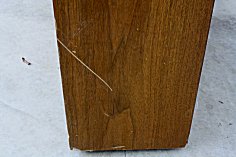 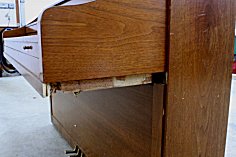 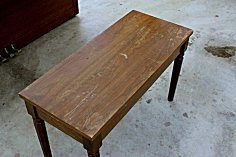 |
The first thing you have to do is see what you're working with.
My first inclination is to always do the least amount possible, not
because I'm lazy, but as an economic courtesy to the person who will
be paying the bill. This project received a cursory
examination at the client's storage shed, a more detailed look in my
garage, then an additional report after I took some things apart to
look under the hood.
It was pretty obvious that this would not be a quick and dirty job
where I could simply refinish a couple pieces of wood and be done
with it. Here is a listing of some of the things I found:
● All of the exposed wood was scratched up.
● Some areas (especially at the lower corners) had the wood veneer
chipped and broken off.
● The front legs were literally ripped off causing considerable
damage.
● One front pull knob was missing, and some other screws were
missing.
● The stool was pretty beat up.
● The piano harp and hammer mechanisms still appeared to be in good
working order (although I'm not a piano tech).
If this were a quick and dirty, minimally invasive approach, I could
have given a fixed price to make the minor repairs. Since this
would be a complete overhaul, we agreed to do this on a time and
materials basis. Some people cringe at that because they were
probably screwed over at one time by a dishonest person.
Truthfully, I don't do woodworking to pay the bills; I have a day
job already. I do woodworking for fun and to see people smile
when I'm done, but I still need to make a little something to cover the cost of
my tools. I can provide a ballpark estimate, but on a project
like this, you simply don't know what you're dealing with until you
start dealing with it. I provided weekly email updates with
photos and a running cost sheet so the client could see where the
money is going and how fast. The client could stop me at any
time, and I didn't require progress payments. There was only
one payment when the whole job was
done. |
|
|
|
Disassemble Everything |
|
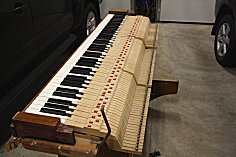 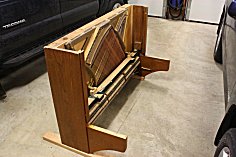 You
can not strip and sand all the wood parts while they're all
screwed together. Stripping works better when the item is laid
flat, and you just have too many tight corners to try to get into.
If the piece comes apart, take it apart. With a larger project
like this, photo document everything, make a list of the order
things came apart, and bag/label the screws for each component. You
can not strip and sand all the wood parts while they're all
screwed together. Stripping works better when the item is laid
flat, and you just have too many tight corners to try to get into.
If the piece comes apart, take it apart. With a larger project
like this, photo document everything, make a list of the order
things came apart, and bag/label the screws for each component.
|
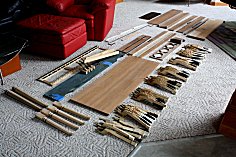 On
this piano, several things came apart in sub-assemblies. The
keyboard, for instance, slid out easily, but then that removed
"tray" came apart in about a dozen more pieces plus the 88 keys.
Label the individual parts on the hidden side or on a piece of tape
so you know where everything goes back in. On
this piano, several things came apart in sub-assemblies. The
keyboard, for instance, slid out easily, but then that removed
"tray" came apart in about a dozen more pieces plus the 88 keys.
Label the individual parts on the hidden side or on a piece of tape
so you know where everything goes back in.
Keep everything organized! This piano came apart in 123 pieces
not counting all the screws and hinges. Lay it all out on the
floor so you don't loose anything and you can see what you're up
against - if not just to annoy the wife. You see, that piano
didn't look like such a big project sitting in the shed. It's
a little different story when you see it like this. |
|
|
|
Strip the Wood |
|
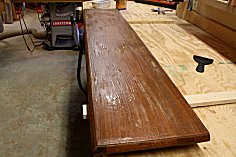 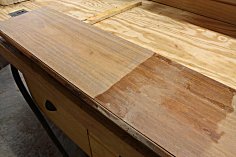 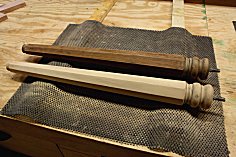 |
|
Stripping finish is not particularly difficult; "tedious" is
probably a better word. Fortunately this piano had more flat
pieces than ones with contours or carving. If you do this
yourself and you're standing at Home Depot looking at the cheap can
of paint stripper versus the expensive can, which do you think you
should buy? Fork up the extra $10 for the expensive can.
It will be the consistency of jelly so it will stick, and it will do
its thing in 15 minutes instead of 45. You simply brush it on
with a cheap chip brush, let it sit for 15-20 minutes, scrape it
off, and sand it.
Don't go expensive on the brush, it'll get dipped into toxic
chemicals. You can wash out the chip brush and use it until it
falls apart Do not use a foam brush; those toxic chemicals
will disintegrate it immediately. I don't use gloves when
doing this, but you have to be aware that if your skin starts
burning, you need to wash it off. Scrape the goo off with a
cheap plastic scraper (plastic doesn't scratch the wood easily) and
a lot of paper towels. Stripping will only remove the clear
top coats from the wood like polyurethane or varnish. Follow
that up with 150 grit in a random orbit sander to sand off the
existing stain, then with 220 grit to smooth it up to accept the new
finish.
After stripping the first few pieces, I found that the wood
underneath was a beautiful, colorful walnut. When furniture is
mass produced, the factory will usually opt for homogenous colors and
sacrifice any cool grain patterns. They do what is called
"toning" where they spray the color onto the surface of the wood.
It's kind of like spray painting, but you can still pick up on some
of the grain underneath. After showing my client the
difference between simply oiling the wood (to bring out the grain)
and toning, she went with oiling. This will really pop the
color and grain patterns out, but there will be some pieces which
will not land in at exactly the same color. |
|
|
|
Clean and Buff Everything Else |
|
|
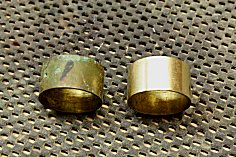 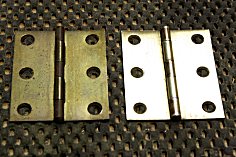 Since
there is a lag between applying the stripper and scraping it
off, there's time to do other things while the stripper is curing.
Don't just sit there and watch the paint dry. Now that you've
got the entire piano disassembled, this would be the best time to
give everything the once over. Since
there is a lag between applying the stripper and scraping it
off, there's time to do other things while the stripper is curing.
Don't just sit there and watch the paint dry. Now that you've
got the entire piano disassembled, this would be the best time to
give everything the once over.
Those tarnished hinges can use some attention. Start with 200
grit sand paper to get the bulk of the corrosion off. Don't
get too aggressive as things might be brass plated and you
don't want to sand off the plating. For stubborn gunk, break
out your Dremel tool with an appropriate attachment. You can
then switch to brass polish after that for those more visible
accessories.
|
|
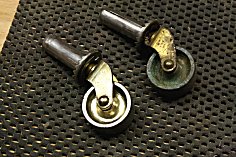 The
client told me I could just throw the old wheels out since they
didn't work anymore. After examination, I found that at some
point someone rolled over a sheet of plastic and completely
clogged up the bearings. After 15 minutes with a small
needle-nose pliers and a dental pick, the wheels worked again.
Some degreaser (like Simple Green) will break down the oily stuff.
Then follow that up with sanding, Dremeling, and polishing. Be
mindful when you have that inkling to just throw out that old part.
Where can you find a small, solid metal caster to hold a 400 pound
piano these days? The
client told me I could just throw the old wheels out since they
didn't work anymore. After examination, I found that at some
point someone rolled over a sheet of plastic and completely
clogged up the bearings. After 15 minutes with a small
needle-nose pliers and a dental pick, the wheels worked again.
Some degreaser (like Simple Green) will break down the oily stuff.
Then follow that up with sanding, Dremeling, and polishing. Be
mindful when you have that inkling to just throw out that old part.
Where can you find a small, solid metal caster to hold a 400 pound
piano these days? |
|
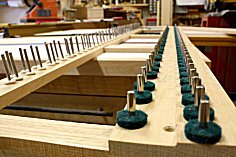 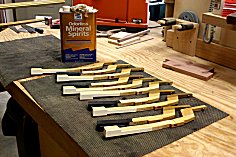 The
keyboard tray was one big dust bunny underneath - along with a few
spider nests. There are 88 keys on a piano, and I became
intimately familiar with every one of these. Before you take
them off, number the keys as they are all unique. I gathered
them up in small sets and thoroughly cleaned each individual key
with mineral spirits. Then I vacuumed the tray carefully so I
didn't suck up those felt pads. The
keyboard tray was one big dust bunny underneath - along with a few
spider nests. There are 88 keys on a piano, and I became
intimately familiar with every one of these. Before you take
them off, number the keys as they are all unique. I gathered
them up in small sets and thoroughly cleaned each individual key
with mineral spirits. Then I vacuumed the tray carefully so I
didn't suck up those felt pads.
|
|
Yes, even take a wire brush to the old screws to knock off any
rust. Again, resist the temptation to replace the screws.
Old screws have slightly different diameters and their thread pitch
is different. If you run in a new screw, you might strip the
wood in that old screw hole. Also, there were over a hundred
screws on this project. Do you really want to catalog every
screw so you can buy suitable replacements? Replace the
original screws only when needed or where you messed up those stupid slotted
heads taking them out. |
|
|
|
Patch the Wood |
|
|
You'll want to do any patching as sparingly as possible. Even
though the patch should be less noticeable than broken or chipped
wood, you don't want the thing looking like a quilt either.
Keeping the existing wood in place is usually the better way to go.
Some woods are simply not available any more like Cuban mahogany,
old growth fir, or in this case a vibrant variety of walnut.
However, if a piece of wood is badly beaten up, you might have to
replace the entire piece with a new one and call it a day.
Here's a description for what's involved with patching a broken
area. |
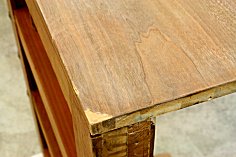 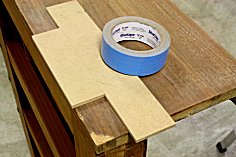 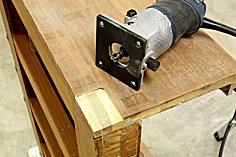 |
|
Chipped veneer is a prime candidate for a patch. You could
never color or stain that and make it look acceptable. First you need
to cordon off the area with some thin material like MDF stuck down
with double-stick (carpet) tape. Then you route out the area
about 1/4" deep. Notice that the sides are nice and square so
you can easily cut a piece of wood to fit back in there. |
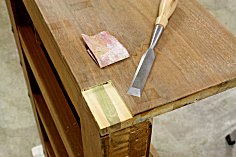 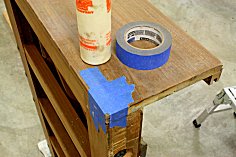 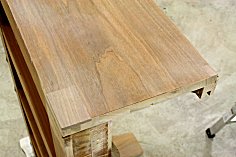 |
|
Clean up the area with a chisel and
sandpaper. Find a piece of wood which best matches the color
and grain of the area. In this case I used walnut. It
was a pretty close match to the variety of walnut originally used.
Once the piece receives the finish, it will just about be invisible.
Size the piece to match the void, glue it up, and tape it in to dry.
In about an hour, remove the tape and sand everything smooth and
flush. Then repeat the procedure for all the areas needing
some love. |
|
|
|
Fix the Major Stuff |
|
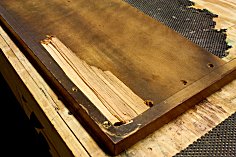 As
I mentioned earlier, the front legs of this piano were completely
ripped out. This would have been extremely difficult to
accomplish unless the person was particularly motivated. The
tray under the keyboard was a 1 1/4" thick piece of lumber.
The top of the leg had a 3/8" diameter threaded stud which screwed
into an insert nut on the other side. The perpetrator would
have had to pull the nut through the piece of wood. As you can
see, he got the leg off and took a good sized chunk of lumber along
with it. Fortunately, the client still had the legs so those
wouldn't have to be recreated. But the damage was done and
needed to be repaired. As
I mentioned earlier, the front legs of this piano were completely
ripped out. This would have been extremely difficult to
accomplish unless the person was particularly motivated. The
tray under the keyboard was a 1 1/4" thick piece of lumber.
The top of the leg had a 3/8" diameter threaded stud which screwed
into an insert nut on the other side. The perpetrator would
have had to pull the nut through the piece of wood. As you can
see, he got the leg off and took a good sized chunk of lumber along
with it. Fortunately, the client still had the legs so those
wouldn't have to be recreated. But the damage was done and
needed to be repaired. |
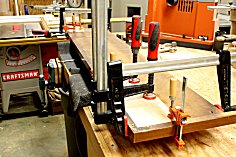 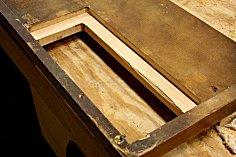 The
offending area was carefully routed away. I left a ledge
around the hole so I could get a little more surface area on which
to apply glue. I cut a piece of birch to fit the hole
perfectly, glued it, and clamped it home. Birch is a very hard
wood; this leg won't be going anywhere. Once the glue dried, I
sanded everything up smooth and flush, then repeated the process for the other
leg. The
offending area was carefully routed away. I left a ledge
around the hole so I could get a little more surface area on which
to apply glue. I cut a piece of birch to fit the hole
perfectly, glued it, and clamped it home. Birch is a very hard
wood; this leg won't be going anywhere. Once the glue dried, I
sanded everything up smooth and flush, then repeated the process for the other
leg.
|
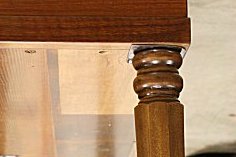 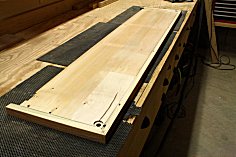 The
holes for the legs' threaded studs were located and drilled through.
A shallow recess on top will house the threaded insert nut.
The patching is only visible from below. No one sill see it
unless someone sticks their head down there ... and I guarantee
there wouldn't be much piano playing going on. The
holes for the legs' threaded studs were located and drilled through.
A shallow recess on top will house the threaded insert nut.
The patching is only visible from below. No one sill see it
unless someone sticks their head down there ... and I guarantee
there wouldn't be much piano playing going on. |
|
|
|
Apply the Finish |
|
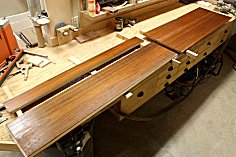 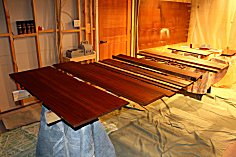 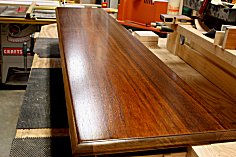 |
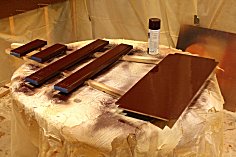 After
everything was sanded smooth, I
applied one coat of linseed oil which really brought out the beauty
of the wood. It darkens it up and really pops that grain.
I followed that up with three coats of semi-gloss polyurethane
lightly sanding between the second and third coats.
Polyurethane is tougher than lacquer, but it takes a day to dry.
Then I applied some paste wax and buffed it smooth which lends a
little luster and gives it a nice feel to the touch - it's hard to
describe - it just feels like new. After
everything was sanded smooth, I
applied one coat of linseed oil which really brought out the beauty
of the wood. It darkens it up and really pops that grain.
I followed that up with three coats of semi-gloss polyurethane
lightly sanding between the second and third coats.
Polyurethane is tougher than lacquer, but it takes a day to dry.
Then I applied some paste wax and buffed it smooth which lends a
little luster and gives it a nice feel to the touch - it's hard to
describe - it just feels like new.
The interior of the existing bench was painted so I sanded and
sprayed on a few fresh coats of paint. I covered every detail. |
|
|
|
Put It Back Together |
|
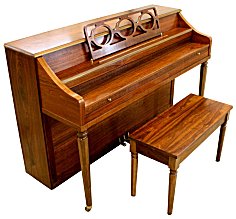 Hopefully
you took good notes and kept all your screws organized. If so,
reassembly is a snap. Take your time so you don't scratch that
freshly finished wood. Now let's take a look at the completed
product. Hopefully
you took good notes and kept all your screws organized. If so,
reassembly is a snap. Take your time so you don't scratch that
freshly finished wood. Now let's take a look at the completed
product.
First off you notice that the finish is beautiful, better than the
original (even when it was new). Look at the wood grain on
that stool. Wow! Go ahead, click on the thumbnails for
the larger photos.
|
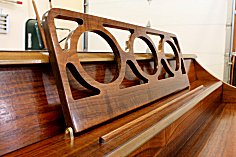 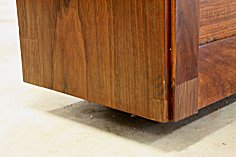 There
are three wood patches in the first photo to the right. Two
blend in pretty good; I'll concede on the third, but these are much
less noticeable than chipped off bare wood. There
are three wood patches in the first photo to the right. Two
blend in pretty good; I'll concede on the third, but these are much
less noticeable than chipped off bare wood.
Everything was refinished including the music stand.
Everything was cleaned and buffed like those music stand mounting
pivots.
|
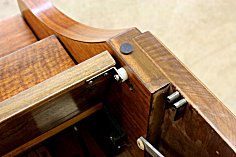 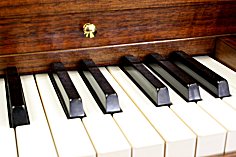 Every
key was hand cleaned. One pull knob on the key cover was
missing. I provided two new ones which were a close match.
Even the issues you can't readily see were addressed. I added a spacer
to the top assembly so the screw wasn't bending that little metal
"L" bracket. I added new rubber bumpers so the top doesn't
slam down. The details! Every
key was hand cleaned. One pull knob on the key cover was
missing. I provided two new ones which were a close match.
Even the issues you can't readily see were addressed. I added a spacer
to the top assembly so the screw wasn't bending that little metal
"L" bracket. I added new rubber bumpers so the top doesn't
slam down. The details! |
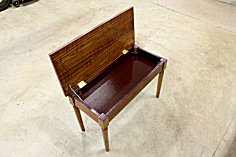 Even
the stool was refinished. Look at the gleam on those buffed
out hinges. This looks like it just came in brand new from the
showroom. Even
the stool was refinished. Look at the gleam on those buffed
out hinges. This looks like it just came in brand new from the
showroom.
Many people want to refinish that old antique, but few are willing
to put in the time to do it right. Did you think this was
going to be a quick weekend job while throwing back a few beers?
This restoration took me 48 hours. It was a labor of love and
I took the time to respect each individual component. That
love shows in the finished product. Now it will be ready to
host my client (and any new grand daughters down the line) to create
new memories of fresh baked cookies and Christmas carols. |